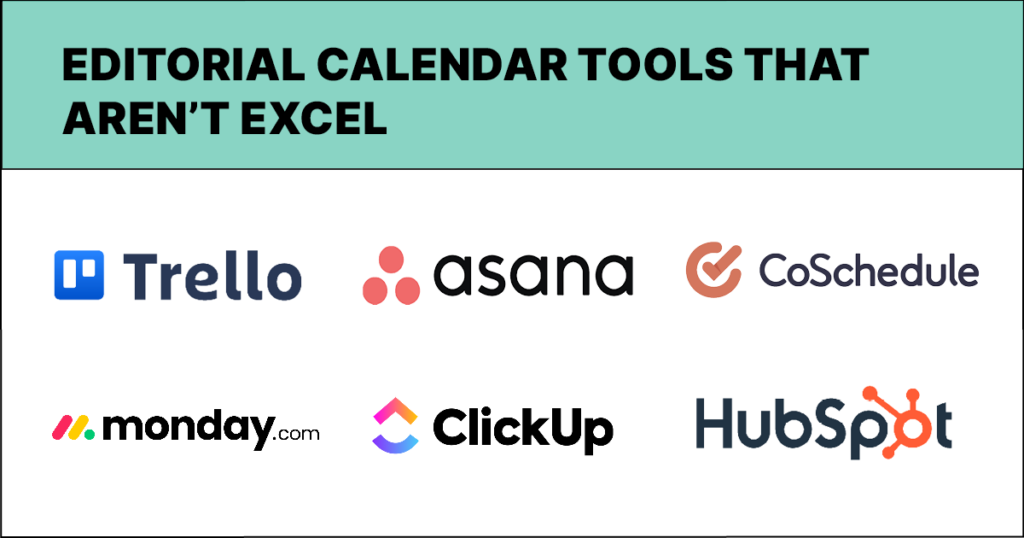Editorial calendar tools are a critical component of any successful content strategy. They allow teams to map out when content will be created, reviewed, published and promoted. The best editorial calendar tools are centralized, visible and facilitate collaboration.
According to Content Marketing Institute, 65% of B2B organizations use some kind of technology for content creation, calendar management and related functions. But only 28% believe they have the right tech for managing B2B content.
The deeper question might be, “What kind of tech are you using?” Despite the many specialized editorial calendar tools available today, many content teams still rely on Microsoft Excel for their editorial calendars.. Our 2022 Career Survey Report, for example, found that over 50% of respondents used Microsoft Office for project management.
Learn more about Excel’s limitations, what to look for in a replacement and how to choose from among the leading software options.
What Is an Editorial Calendar?
Editorial calendars (also known as content calendars) are more than just schedules. They’re strategic tools that align marketing efforts with business goals, audience needs and brand messaging. They ensure consistent content creation, track performance and help teams capitalize on trends.
Without an editorial calendar, content teams will struggle to stay on schedule, coordinate work and ensure that everyone knows what they’re responsible for. Planning a long-term content strategy is also more difficult when there’s no singular source of information.
Microsoft Excel: A Flawed Content Planning Tool
Most B2B content marketing teams have access to Excel or Google Sheets as part of a larger tech ecosystem. It’s understandable why these tools have become the default. While Excel offers many benefits for power users of spreadsheets, it lacks key features found in leading editorial planning tools.
For example, Excel makes it difficult to get a high-level view of the entire editorial calendar. Traditionally, multiple users couldn’t edit Excel files simultaneously, and version control was a perpetual problem. Even today, co-authoring requires a Microsoft 365 subscription. Using Excel for content calendars requires substantial manual data entry, which can lead to errors. Most importantly, Excel doesn’t easily enable a deep analysis of content performance and trends over time.
Thankfully, a new breed of dedicated editorial calendar software has emerged. These tools provide content teams with visibility, integrations, automation and analytics.

Key Features to Look for in Editorial Calendar Tools
As content marketing teams move away from Excel, it’s crucial to identify which features will improve content planning and execution. A perfect editorial calendar should include the following capabilities.
Enhanced Visualization and Usability
- Calendar views: Look for tools that offer various calendar views (monthly, weekly, daily) to help visualize the content pipeline. Having multiple views helps content marketing managers during planning and is useful during wider presentations.
- Drag-and-drop functionality: This feature simplifies calendar editing. You can reschedule and rearrange content in real-time without leaving the current window, making planning more intuitive.
Robust Collaboration and Workflow Management
- Real-time collaboration and control: Editorial calendar planning goes smoothly when multiple users can view the calendar at the same time. These tools should offer multiple permission levels to maximize visibility while keeping control of the content leader.
- Task assignment and tracking: The best content calendar tools allow administrators to assign tasks to team members with clear visibility into task and project progress.
Integration With Other Marketing Tools
Your content planning tool should seamlessly integrate with key software, including content management systems, social media platforms and analytics tools. These integrations improve version control, prevent duplicate effort and streamline workflows.
Content Performance Analytics
An ideal content calendar tool should provide insights into content performance, enabling teams to make data-driven decisions.
Customization and Scalability
The tool should be flexible enough to adapt to your content marketing operation’s distinct needs, both now and as your organization scales.

The Best Editorial Calendar Software Options
For teams ready to make the switch, several editorial calendar tools stand out for their specialized features, ease of use and ability to enhance content marketing strategies. Here are some of the top alternatives.
Trello
About: Trello is a versatile project management tool known for its simplicity, visual card-based system and customizable boards. Content marketers can use Trello for managing editorial content and a host of other purposes across marketing, design and engineering teams.
Key Features:
- Create visual workflows with customizable boards, lists and cards.
- Easily integrates with applications including Slack, Google Drive and Dropbox.
- Quickly attach files directly to cards within Trello.
Advantages:
- Intuitive interface designed for color-coding and categorizing projects.
- Customizable and adaptable for different workflows.
- Allows teams to automate repetitive workflows.
Disadvantages:
- Lacks some editorial-specific features, such as task dependencies.
- Most reporting and analytics capabilities require integrations.
- Best for small to medium teams; may be less effective for larger companies/projects.
Pricing:
- Comes in a free version and multiple paid plans starting at $5 per user per month.
Asana
About: Asana is a comprehensive task and project management software with a focus on workflow management and task tracking.
Key Features:
- Manage multiple projects with lists, attachments, assignees and due dates.
- Enjoy multiple views for better project visualization.
- Use Asana across teams, including IT, strategic planning and operations.
Advantages:
- Suitable for a wide range of projects and tasks.
- Extensive customization options, including the artificial intelligence tool Asana Intelligence.
- Hundreds of app integrations for enhanced functionality, including Slack, Adobe Creative Cloud and Salesforce.
Disadvantages:
- Can be overwhelming for simple editorial calendar needs and can require a steep learning curve.
- More of a general tool for organizational-wide use, with limited content-specific features.
Pricing:
- Get started with a free version, paid plans starting at $10.99 per user per month, and enterprise options.
CoSchedule
About: CoSchedule is an all-in-one content marketing calendar designed for marketing teams. It’s known for its visualization, integration and collaboration features.
Key Features:
- Quickly plan your calendar with easy-to-use drag-and-drop functionality.
- Schedule posts across multiple social media platforms.
- Integrate with Google Docs, social channels and other tools.
- Get content ideas and fine-tune headlines, subject lines and more.
- Access robust analytics capabilities for content and social media performance.
Advantages:
- The marketing suite offers a complete solution for content scheduling, social media marketing and task management. Social and content calendars are also available for users who need less functionality.
- All marketing activities can be centralized under a master calendar.
- Create reusable task templates and save blog ideas for later, among other calendar features.
Disadvantages:
- Potentially expensive for larger teams and requiring learning time.
- Primarily focused on content marketing, which may be too narrow for larger project management needs.
Pricing:
- The free plan offers limited, single-user features. Content marketing teams need to contact sales to discuss pricing.
Monday.com
About: Monday.com is a work operating system that teams can tailor to their project and editorial calendar management needs.
Key Features:
- Build visual dashboards and charts to track workflows.
- Integrates with Slack, Dropbox, Google Drive and more.
- Easily supports a wider work ecosystem across departments and functions.
Advantages:
- Easily collaborate through an intuitive user interface that promotes transparency and accountability.
- Users can automate repetitive tasks for greater efficiency.
- One system for setting strategy, managing projects and assigning tasks.
Disadvantages:
- Monday.com can be too much of a system for companies that just need to manage a content calendar.
- Potentially expensive for larger teams and better suited for technically adept users.
Pricing:
- Offers a free version for up to two users that could help your team test Monday.com’s suitability. Multiple paid plans are available, as well as enterprise-level support.
ClickUp
About: ClickUp is a cloud-based project management tool designed for teams that can assign tasks, report on progress and send notifications.
Features:
- Enjoy more than 15 distinct view options, including calendar, Kanban, timeline and list views.
- Organize and manage projects with customizable tasks and subtasks, automations, free templates and more.
Advantages:
- Free content calendar templates and automation tools to speed up your workflows.
- Integrations include Google Drive, Salesforce, Figma and more, plus a custom API.
Disadvantages:
- Onboarding can be challenging because of all the features and options.
- Some users report bugs and poor customer support.
Pricing:
- Comes with a free plan with limited functionality, as well as multiple paid plans and enterprise-level support.
HubSpot
About: HubSpot is a customer platform that helps companies manage marketing automation, content publishing, customer relationship management and much more.
Features:
- Offers a distinct content management system.
- Easily integrates with your other sales, marketing and customer efforts.
- Build and host websites with drag-and-drop capabilities.
Advantages:
- Advanced functionality across a host of business needs without sacrificing content management.
- Content for your blog, landing pages, social channels and marketing campaigns can be managed in one place.
- SEO optimization is available within the same tool you use to plan and publish blog posts.
Disadvantages:
- All-in-one focus makes it less useful for teams that just need content calendars and related functionality.
- Offers editorial calendar templates but doesn’t host them. You’ll need to use spreadsheets or Google Calendar.
- Potentially expensive as you add features and services.
Pricing:
- The CMS Hub starts at $360 per month, while the CRM Suite starts at $1,600 per month.
Honorable Mentions
- Loomly: Loomly is a social media management platform. While it has calendar functionality, it’s focused on social media rather than full-spectrum content creation. There’s no free plan.
- Notion: Notion is an AI-powered workspace tool that offers extensive customization, wiki-like features and more. If you don’t need a custom setup, however, this might prove too high-maintenance.
- WordPress: Many brands use WordPress for their publishing. While WordPress doesn’t come with a calendar view, you can install a plugin.
- Wrike: As a project management platform, Wrike can help your team organize content planning, client management and other tasks in one place. It’s more of a task management system than an intuitive content planning tool, however. Pricing accelerates quickly when seeking advanced capabilities or adding more than 25 users.
Choosing the Right Editorial Calendar Tool
With those leading options in mind, how should teams evaluate the right tool for their needs? Key factors include:
Price and Perceived Value
Weigh the total cost against the expected efficiency gains and return on investment. Consider the base costs of your current technology and contract terms against other options. You might pay more for a robust tool but recoup that expense in the opportunities gained.
Features and Functionality
Determine your organization’s must-have capabilities based on workflows and goals. Avoid the mistake of buying the tool with the most features. You might be wasting money on bells and whistles you don’t use, and your team might struggle to get up to speed. On the other hand, adopting software that doesn’t contain features you currently use will create frustration and harm productivity.
Ease of Use and Learning Curve
Intuitive user experiences ensure higher adoption rates. Ask about the vendor’s support during and after implementation. On-demand text and video resources can be especially helpful for onboarding a large team or new hires. Meanwhile, live training and demos can be essential early on, as live experts can easily answer pressing questions.
Ability To Integrate With Existing Tools
Make sure the new tool maintains existing integrations and adds new functionality. Test these integrations, if possible, before committing. Consider not only the integrations your content marketing team uses but also those in use by other teams, including sales and customer service.
Options For Sharing And Collaborating
Ensure visibility for all users, including stakeholders outside the marketing team. At the same time, make sure there is robust administrator control so you can assign the proper permissions to each user.
Opportunities For Automation And Analytics
Features like automated workflows, notifications, scheduling and tracking help organizations be more efficient so they can focus on the strategic aspects of editorial calendar planning.
Transitioning from Excel to a Specialized Editorial Tool
As your content marketing team transitions away from Excel, you want a smooth onboarding process. Here are some best practices:
- Export existing editorial calendar data from Excel: Save the Excel sheet as a CSV file for importing into the new software.
- Set up relevant integrations: Connect required programs and establish single-sign-on access.
- Assign admin rights: Select a point person to configure system settings and workflows.
- Create onboarding schedules and materials: Schedule demos and access to resources, including video tutorials and vendor customer service, so your team can get up to speed while having questions answered.
You Don’t Need Excel to Excel
While many content marketing teams are comfortable using Excel, there are better editorial calendar tools out there for managing a modern content strategy. This is especially true when your content strategy needs to align and interact with marketing, sales, operations and other business functions.
Transitioning from Excel to a more specialized editorial calendar tool can revolutionize your content marketing strategy. Enjoy better visualization, easier collaboration, seamless integrations and ready-made insights and analytics. By choosing the right editorial calendar tool, teams can ensure their strategy aligns with the business, adapts to market changes and delivers measurable results.
For more expert insights and helpful tips, subscribe to Managing Editor’s weekly newsletter.






